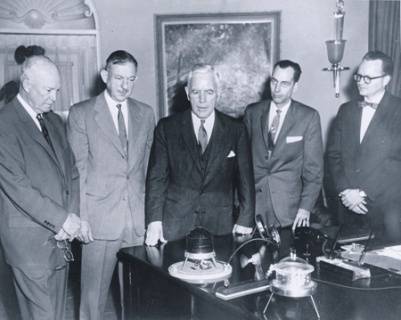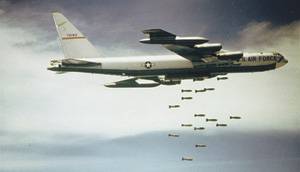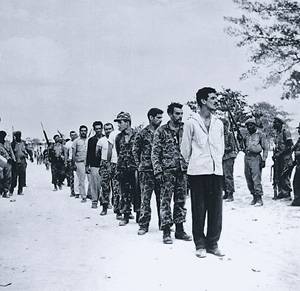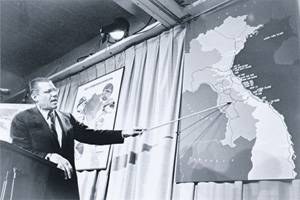CIA takes revenge

The future director of the CIA, John McCone (pictured center) in the presidential administration Eisenhower (pictured left) headed the Atomic Energy Commission.
American military and civilian intelligence always existed in an atmosphere of rivalry, although neither side explicitly refused to cooperate. During the Second World War and in the early postwar years, the situation in the format of CIA relations — military intelligence as a whole remained relatively calm, but at the turn of 50 – 60-s, the situation began to change quite quickly. Such prominent military intelligence figures as Admiral S. Sawers, General of the Air Force H. Vandenberg, Admiral R. Hillenkotter and General B. Smith, in a joint statement stated that intelligence should be primarily a providing body for the Armed Forces, providing them with necessary for conducting military operations information, and not to substitute the Armed Forces as a fighting force, and especially not to interfere in politics. There were fears that the fascination for intelligence with political intrigues would complicate the resolution of military problems and reduce the reliability of the information necessary for the Armed Forces.
In the end, military intelligence officers, in fact, of all the organizations of the US Department of Defense expressed the desire to have their own centralized command structure independent of the CIA. In turn, the head of the CIA, Allen Dulles, not without reason believed that in the event of centralizing the military intelligence directorate, the new body in charge would inevitably step up one level with the CIA, and its leader would automatically have direct access to the president, bypassing the head of the CIA. Moreover, the authority of the new body will increase due to the fact that the centrally processed information from military intelligence and submitted to the country's leadership will be qualitatively higher than that obtained from similar but more limited sources under the CIA.
WHITE HOUSE GOES TOWARD PENTAGON
Despite the powerful resistance to the realization of this idea by the CIA and personally by its head A. Dulles, the presidential administration began to lean in favor of the Pentagon’s point of view. The reason for the final decision on this issue was the hot debate at the beginning of 1960, in the US legislative bodies, where intelligence representatives of the Armed Forces expressed their complete disagreement with the intelligence intelligence of the CIA regarding the growth rates of the Soviet military potential and especially its nuclear missile weapons. To resolve the conflict, the issue was referred to a special joint group of representatives of intelligence agencies headed by CIA Inspector General Lymon Kirpatrick. At the end of 1960, the group developed its recommendations and was forced to recognize the need to establish a central military intelligence unit and introduce its leader to the Intelligence Council instead of three independent intelligence agencies of the US Armed Forces. It is noteworthy that this proposal was supported by Tom Gates, the Secretary of Defense of the outgoing Eisenhower administration, and took as a guide to action the new head of the military department of the already democratic administration Robert McNamara. The latter, being the Democratic candidate for the post of minister even during the election campaign, by his own admission, was struck by “wastefulness caused by duplication of work of intelligence agencies not only in the Intelligence Society of the country as a whole, but also within the national armed forces in particular.
Thus, the idea of creating a centralized military intelligence command body, in principle, did not cause any particular objections among the democrats who won the presidential elections, but the decision on this matter was postponed for some time for objective and subjective reasons. In the same year 1960, a new independent reconnaissance structure was created within the Ministry of Defense - the National Aerospace Intelligence Directorate (NUVKR), which was officially determined by the urgent needs for “covering” the territory of the “potential enemy” represented by the USSR, whose success in creating of nuclear potential caused increasing concern in Washington, and the CIA could not object to, whose leadership recognized the objective need at least to centralize control space, and along with it, and aerial reconnaissance.
 The change of presidential power in January 1961 and the transition of the White House from Republicans to Democrats almost automatically assumed a change of leadership in the CIA, which most likely was fraught with significant organizational changes within the framework of the US Intelligence Community as a whole.
The change of presidential power in January 1961 and the transition of the White House from Republicans to Democrats almost automatically assumed a change of leadership in the CIA, which most likely was fraught with significant organizational changes within the framework of the US Intelligence Community as a whole.However, the director of the CIA, A. Dulles and his entourage, nevertheless, in anticipation of possible changes, continued to "play their game." Trying to please candidates from both competing political parties, the CIA, however, was perplexed by the intention of the Republican nominee to the country's top post, Vice President Richard Nixon, to reduce the influence of intelligence agents on the decision-making process at the White House. Under these conditions, Dulles, with the support of certain circles in the country's special services, very favorably perceived the growing popularity among the voters of the "relatively inexperienced" Democratic senator John Kennedy, who in the end won the election.
OPALA DULLES
According to many American researchers, Dulles' self-confidence was the reason that he incorrectly calculated the possible reaction of the new president to the operation to invade 1961 in April on the territory of revolutionary Cuba (the landing of troops in the Bay of Cochinos) supported by the CIA Cuban mercenaries-counterrevolutionaries. . This allegedly was the direct reason for the subsequent disgrace of the almighty Dulles. Despite the fact that subsequently John F. Kennedy, as the leader of the country, took over the entire responsibility for the failure of the operation, he had to put a lot of effort into trying to eliminate such things in the future. Kennedy initially decided to analyze the activities of the special services on the eve and during the failed operation, for which he created a special commission.
It turned out that, despite Kennedy’s personal warning to the CIA’s leadership regarding the need to “thoroughly examine each step of the operation and its possible consequences,” the intelligence officials not only failed to provide the invasion from logistical and operational points of view, but periodically introduced mislead the country's leadership on the preparation of the operation and its "political cover". A certain share of responsibility, as the subsequent investigation showed, was carried by the military as well. The president literally on the eve of the invasion categorically banned the participation of the American Armed Forces in this operation. Defense Secretary Robert McNamara, the Committee of Chiefs of Staff and official representatives of the US military intelligence nevertheless tentatively concluded that "from a military point of view, the success of the planned operation is beyond doubt." Optimism was instilled by the CIA, organized in coordination with the US military, training of Cuban insurgents in training camps of the US Army in Panama and other neighboring countries, as well as the decision to allocate 16 first, and then 8 light fighter-bombers from the National Guard of the USAF (Arkansas) for ensure the landing of the Cuban assault in the Bay of Pigs.
However, Dulles and his entourage went on an unprecedented step, trying to take responsibility for the failure of the presidential administration, which allegedly "tied the intelligence officers and the military hand and foot," not allowing them to maintain the invading forces "even at the minimum level." All these facts provoked sharp discontent of the new presidential administration with the leadership of the CIA and again, although this time without consequences, they initiated the question of the separation of powers between the director of Central Intelligence and the director of the CIA.
23 November 1961 of the year Dulles received an "honorable" resignation (30 died on January 1969 of the year due to complications in the lungs caused by Asian flu), and President Kennedy announced the appointment of a new CIA director. He chose John McCone, who served as Deputy Air Minister in the administration of Harry Truman and director of the Atomic Energy Agency in the administration of Dwight Eisenhower. Following this, all his Dulles devotees' devotees were gradually replaced. It is noteworthy that instead of the deputy head of the CIA, General Keybel, another general was appointed - Sylvester Carter, even though Kennedy originally wanted to see a civilian in this post. However, the military establishment, with the support of congressmen, insisted on the candidacy of the military. Under these conditions, a very significant and fraught with negative consequences for the CIA was the decision of the president that henceforth the administration should not direct any "special militarized operations", the specifics of which are supposedly better understood by the military special services. McCone supported the president by publicly stating that the CIA should "gather intelligence information, analyze and evaluate it," and not become a "department of cloaks and daggers."
RUMO GOES ON THE ARENA
 October 1 1961 of the Ministry of Defense Directive No. 510521 was established by the Defense Intelligence Agency (RUMO) to, as representatives of the presidential administration noted, “put a centralized decision-making and order-giving authority over military intelligence services of all types.” RUMO received permission to create abroad its agent network, not controlled by the CIA. This breadth of authority of RUMO caused “soft” objections from the new leadership of the CIA, who asserted that “there is practically no area of activity of centralized military intelligence that the CIA would no longer do”. But it was too late.
October 1 1961 of the Ministry of Defense Directive No. 510521 was established by the Defense Intelligence Agency (RUMO) to, as representatives of the presidential administration noted, “put a centralized decision-making and order-giving authority over military intelligence services of all types.” RUMO received permission to create abroad its agent network, not controlled by the CIA. This breadth of authority of RUMO caused “soft” objections from the new leadership of the CIA, who asserted that “there is practically no area of activity of centralized military intelligence that the CIA would no longer do”. But it was too late.The first head of the RUMO, who held this position from October 1961 to September 1969, that is, two terms assigned to serve on this intelligence unit, was appointed Air Force Lieutenant General Joseph F. Carroll, who had served previously in the counter-intelligence service of the Air Force. After some time, on the basis of supposedly practical necessity, it was decided that the head of the police department is obliged to submit his reports directly to the head of the military department of the country, bypassing the KSSH. A few months later, McNamara, whose opinion was listened not only to the White House, but also to Congress, said that "henceforth the head of the military department no longer needs to receive intelligence information from other sources not controlled by military intelligence." Of course, this was an exaggeration, but on the whole, reflecting the general trend of growth in the authority of military intelligence.
In the 1964 year, when the RUMO was fully operational, it numbered over two and a half thousand employees — officers and civilians. The Defense Intelligence Agency has banned the publication of print publications, secret and unclassified, by each intelligence unit of the US Armed Forces separately, replacing them with their “centralized” publications. Only the veto of President Lyndon Johnson subsequently prevented the leadership of the RUMO from becoming the sole representative of the military department in various advisory councils under the president, the National Security Council and the legislature. The warnings of Allen Dulles began to come true: “It cannot be ruled out that two such powerful and generously funded organizations, like the CIA and RUMO, will become rivals and competitors!”
In the meantime, the Kennedy Administration continued to streamline the intelligence business proposed by the Failure Investigation Commission with the invasion of Cuba in April 1961. As one of them, taken by the president as a result of the investigation, was the creation of the Presidential Advisory Council on Foreign Intelligence. In 1963, the trustee of the president, one of the “architects” of the National Security Act of 1947, Clark Clifford, the future US Secretary of Defense, was appointed chairman of this body. At the head of the 5412 Committee for National Security, the President put General M. Taylor, who rejected John Kennedy’s initial offer to head the CIA.
Taylor, guided by the instructions of the president, conducted through the National Security Council directive memorandums No. 55 and 57, in accordance with which the so-called paramilitary operations were transferred from the CIA to the US Department of Defense, in fact to military intelligence. It was further specified that, even if such actions were developed by the CIA, the military was now responsible for their implementation. However, American researchers emphasize that such a decision by the National Security Service rather reflected intra-departmental rivalry within the country's Intelligence community, since it was initially obvious that priorities not only in the preparation of this type of actions, but also in their implementation, could belong only to the CIA. That is why, William Colby, one of the leaders of the administration in 70, stresses in his memoirs, “Taylor’s recommendations for the CIA remained generally on paper.”
AUTHORS VIETNAMA AVANTURE
 Meanwhile, personnel changes in the CIA continued. Instead of Bissell, who was the right hand of the disgraced Dulles, the personnel intelligence officer R. Helms, who was considered to be an expert in the collection and analysis of information, was appointed to the post of chief of the lead in the management of the planning directorate. With this appointment, the president emphasized the shift in priorities in the work of the CIA: the transition from planning and implementing “paramilitary actions” to working with information and bringing it to the highest echelons of power in Washington. However, as the researchers emphasize stories special services, if there were illusions with Kennedy and his entourage about the possibility of "taking control of the CIA," then they were in vain.
Meanwhile, personnel changes in the CIA continued. Instead of Bissell, who was the right hand of the disgraced Dulles, the personnel intelligence officer R. Helms, who was considered to be an expert in the collection and analysis of information, was appointed to the post of chief of the lead in the management of the planning directorate. With this appointment, the president emphasized the shift in priorities in the work of the CIA: the transition from planning and implementing “paramilitary actions” to working with information and bringing it to the highest echelons of power in Washington. However, as the researchers emphasize stories special services, if there were illusions with Kennedy and his entourage about the possibility of "taking control of the CIA," then they were in vain.It was under the new leadership of the CIA that when Kennedy was president, a large-scale intervention, unthinkable under his predecessors, was initiated in the internal affairs of the countries of Southeast Asia, which contributed to military escalation in the region, and above all in Vietnam. In the autumn of 1963, a coup was planned in the capital of South Vietnam, which killed President Ngo Dinh Diem and his brother, who lost control of Washington, and intensified military operations against the South Vietnamese rebels. It is noteworthy that this was done contrary to the recommendations of the military intelligence, which in its analytical reports already predicted the inevitability of the introduction of significant contingents of US troops into the region with negative consequences for the country. US President Kennedy, who survived the South Vietnamese dictator by only three weeks, allegedly also doubted the “benefits of a change of leadership in Saigon” and expressed concerns about the coming increase in tensions in the region as a whole. However, the process of escalation of tension, initiated by the CIA, was already impossible to stop.
The new president of the United States, Lyndon Johnson, who has chosen the new order of doing business in the field of foreign policy, began to focus primarily on the opinion of the director of the CIA. In June 1964, the so-called 5412 Advisory Committee, which discussed including intelligence issues, was renamed the 303 Committee, which was reasonably perceived in Washington circles as a shift in intelligence activities to the side once again gaining influence from the CIA. CIA Director McCone restructured the work in accordance with the personal wishes of the new president, who subsequently noted the fact of "a significant improvement in intelligence work."
The revitalization of the work of the CIA was expressed primarily in targeting its activities in Southeast Asia in order to radically change the situation there in the fight against the "communist threat". At the direction of McCone, the best intelligence personnel were sent to South Vietnam. The recommendations of the military regarding the “definite” reinforcement of the military contingent of American troops in the region were regarded by the CIA leadership as “miserable” and “belated”. The leadership of the CIA recommended that Johnson expand the scope of US military intervention in North Vietnam by direct bombardment of not only military, but also civilian objects in this country. These tips were perceived by the president as "constructive." In the spring of 1965, the analytical unit of the CIA prepared relevant memoranda to be sent to the country's leadership, including the Department of Defense, which essentially justified the need for a sharp expansion of US military intervention in the affairs of the countries of the region, which, among other things, required more active involvement of military intelligence structures, including air and space.
By the end of 1964, the US Department of Defense, led by R. McNamara, took a more belligerent position on the issue of expanding military intervention in Southeast Asia than even the CIA. McNamara, speaking from the standpoint of the strategy of the “front lines” and “rejecting communism”, entered into an open debate with the head of CIA McCone, who warned the president about possible direct intervention in the conflict in Vietnam of communist China. The Minister was supported by the Chairman of the KNS, General Lyman Lemnitzer, who, during the life of John Kennedy, put forward a plan to use nuclear weapons against Indochina and, if necessary, against China.
In the autumn of 1964, the Ministry of Defense and the CIA, with the tacit consent of the President, planned and carried out the so-called Tonkin incident, as a result of which two American destroyers, directly subordinate to military intelligence, provoked the attack on them of torpedo boats of North Vietnam. In response, Washington “was forced” to launch a wide-ranging air campaign against Hanoi.
Intelligence information about North Vietnam as an “aggressor” served as a trump card to Johnson and his successor Nixon to escalate the air war and expand the scale of hostilities throughout Indochina. The content reports of the representatives of both the CIA and military intelligence to the legislators and the media were designed to demonstrate the unity of intelligence assessments and the inevitability of the “right decisions” made by the country's leadership.
Information